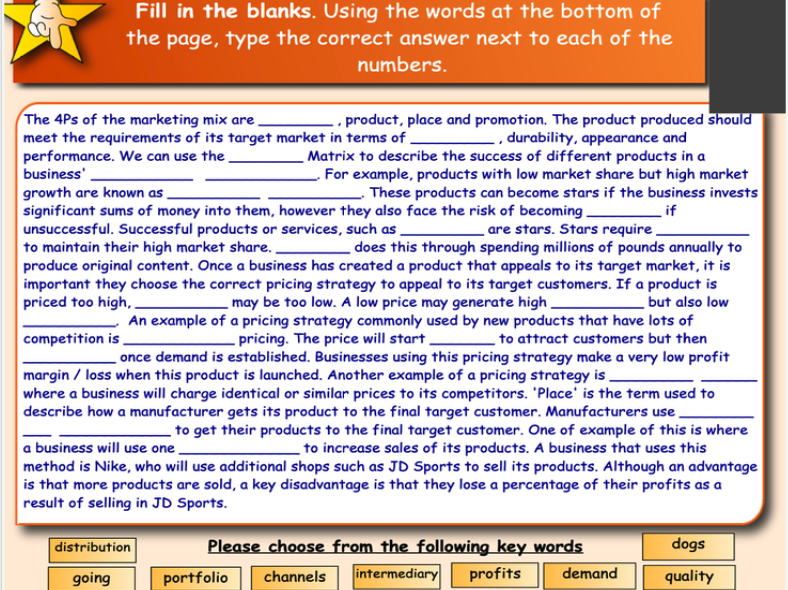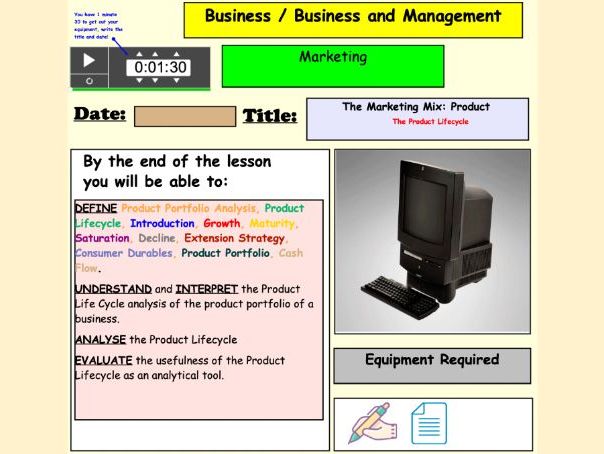83Uploads
9k+Views
5k+Downloads
All resources

Globalisation / Introduction to International Marketing
Using MCDONALD’S TSUKIMI BURGER, Tesco’s failure to succeed in the US, Apple’s failure to succeed in India, and many others, this PowerPoint seeks to explore the reasons why businesses wish to sell in international markets, the challenges and constraints.
Included in this PowerPoint:
A detailed title page, outlining the key skills covered in this topic
A recap on moving averages with answers. This topic is included in some syllabi earlier in the marketing unit but can be deleted if not required
A starter activity introducing the concept of globalisation where students need to match McDonalds products based on the country whey are sold
(demonstrating how products need to be adapted based on the market they are targeting). Answers are provided
An explanation of reasons why businesses choose to sell products in overseas markets
A contextualised example for each reason
Detailed explanations as to each of the reasons why how marketing activities need to change depending on which country goods are being sold
Video 1: Reasons why Tesco failed in US (poor marketing)
Video 2: Reasons why Apple failed in India (poor marketing)
Introduction to some of the factors that make trade between countries easier
This lesson took me an hour and a half to go through.

Maslow's Hierarchy of Needs
Full resource (68 slides) on Maslow’s hierarchy of needs.
Included in this resource:
Colourful and interactive title page , including timer and auto date
Catchphrase starter activity (with answers)
Step by step explanation of each need in the hierarchy
Contextualised examples
Trivia activity
Exam skills activity with answers

Fraud and Identify Theft
This is designed as a follow on lesson to my previous financial education lesson on advertising, media and peer pressure but can be taught as a standalone lesson.
Including in this lesson:
Guess the question starter activity
Explanations of types of fraud, such as phishing and vishing
Videos
Activities with answers

Interpreting elasticities worksheet
Attached is a worksheet on PED, XED, YED and PES.
Students need to calculate the values as well as interpret what the values mean, such as whether demand is price elastic or inelastic (PED), or if goods are complements or substitutes (XED), etc.
There are 16 questions in total.
All answers are included, allowing you or the students to review and grade the worksheet.

Economic Growth / GDP PPT AND Worksheet
This resource provides a comprehensive overview of how GDP is used to measure economic growth. Included in this resource:
A colourful and engaging title slide with learning objectives, animations, auto date, timer and bell
Recap starter activity on basic economic vocabulary (tile reveal activity). Answers included.
Detailed explanations of economic growth, GDP, GDP per capita, real GDP, total GDP, GPD value and volume, and GNI
Activities with answers for most of them (guess the price inflation activity for real GDP, GDP inflater activity - both with answers)
Detailed notes
Contextualised examples
Worksheet with tasks linked to PPT content. Activities include past paper questions, calculation activities and a ranking of nominal GDP task
This presentation and worksheet took roughly two hours to complete with my students.

Comparative and Absolute Advantage
This is a complete lesson on comparative and absolute advantage.
The presentation explains both step by step and includes a range of games, activities and questions throughout.
There are also a couple of past paper questions with answers at the back.
A key term editable starter activity is included at the start.
Engaging and colourful throughout.
This presentation contains 45 slides and took me an hour and a half to go through with my students

Business Growth (Business and Economics)
Complete resource that explores organic and inorganic growth as well as constraints on growth

Purchasing Power Parity (Economics)
Colourful, engaging and informative lesson on PPP. Resource includes:
Colourful title slide with timer, learning objectives, animations and auto date
Editable recap starter activity on GDP / Economics growth
Step by step guidance as to what PPP through a range of activities relating to currency and exchange rates
A number of games and activities included, with answers
Sample PPP questions
There is a simple worksheet included

Indirect Taxation - Economics
This presentation contains 73 slides and introduces what tax is before going into detail about indirect taxation and how to interpret diagrams that ask questions on indirect taxation.
Included in this presentation:
A Catchphrase starter activity
A true of false short quiz that asks students about 4 different types of tax around the world
Information about how much tax is generated in UK compare to poorer countries, what that tax revenue is spent on and how it is sourced
Distinctions between direct and indirect taxes. Although Econs exams focus more on indirect taxes, explaining direct taxes gets students engaged into the lesson
A ‘how much tax does BOJO pay’ activity that students really enjoy
Notes on indirect taxation
A step by step explanation of how to interpret and make calculations on tax diagrams
A calculation activity that students need to complete
Notes on disadvantages of tax increases
Evaluative suggestion points the extent to which tax rises are harmful
These slides took me an hour and a half to go through with my students.

Cross Elasticity of Demand
This PowerPoint includes:
An activity that introduces students to the concept of complements, substitutes and unrelated goods
A activity where students have to match pairs of complement and substitutes goods
An activity where students have to calculate the XED of a pair of goods
Detailed notes on how to calculate XED and what the data means
This presentation contains 21 slides and took me 45minutes to complete

Cross Elasticity of Demand
This PowerPoint includes:
An activity that introduces students to the concept of complements, substitutes and unrelated goods
A activity where students have to match pairs of complement and substitutes goods
An activity where students have to calculate the XED of a pair of goods
Detailed notes on how to calculate XED and what the data means
This presentation contains 21 slides and took me 45minutes to complete

Marketing Mix RECAP STARTER
A fill the blanks activity on the 4Ps with emphasis on Boston Matrix
Answers are included
This is useful as a starter activity or plenary

Average Rate of Return
Included in this lesson:
A detailed and colourful title slide, including all learning objectives for this topic
A recap starter activity on calculating the payback period (answers included)
An explanation slide as to what the lesson is about; providing an overview of the problems of relying solely on the payback period as a method of investment appraisal and why other methods are also needed
Explanation of what ARR is
A scenario showing how ARR is calculated
An evaluation of ARR
There are 22 slides in total and it took me around 30 minutes to go through the presentation.

Market Failure (Types of)
This lesson introduces the concept of market failure and explains what each of the key types of market failure are (externalities, under-provision of public goods and information assymmetry)
Included in this presentation is:
A colourful title slide with the key learning objectives
A ‘guess the question’ starter activity with answers
A step-by-step explanation as to what market failure is
Video showing an extreme example of externalities
Fill the blanks externality activity
Externalities sorting activity with answers
Positive externality activity
Information gap activity
Detailed and colourful notes throughout
This presentation is 32 slides in length and took me one hour to go through

Market Structures and Competition
This lesson can be used either to teach Business students about competition, market structures and how consumers can be affected by anti-competitive practices OR to teach Economics students about the different features of market structures and why competition / a lack of competition affects different stakeholders.
Included in this lesson:
A colourful and detailed title slide outlining the key learning objectives
An income elasticity of demand starter activity suitable for both Business and Economics students (calculation / explain / diagram question). A printable slide of the questions has been provided with a detailed answer key on next slide for peer marking.
A detailed and contextualised example of how a lack of competition affects different stakeholders (Epic Games legal battle with Apple over Fortnite)
Brainstorming activity on competition
A rank in order activity on types of competitive markets
Detailed notes on competition, monopolies, oligopolies, monopolistic competition, perfect competition, Game Theory, types of anti-competitive practices such as Cartels, OFT.
This presentation contains 37 slides and took me an hour to go through with my students.

Business Location
A 20 slide PowerPoint presentation outlining the qualitative and quantitative factors businesses consider when choosing a business location.
The PowerPoint is colouful, informative and includes a ‘Tenable’ game show PowerPoint where students have to identify 10 common reasons why businesses fail

Marketing Mix - Price
This resource is a 58 slide PowerPoint presentation that gives a comprehensive overview of pricing strategies. Included in this resource:
A colourful title page outlining the learning objectives
A fun catchphrase starter activity where students have to guess the name of a business / product from the pictures given [answers included]
A critical path analysis recap activity [answers included]
An introductory explanation of the importance of pricing products correctly
Detailed explanations with examples of market-based, competition-based and cost-based pricing strategies
Colourful examples provided throughout
Calculation activities [with answers] for the cost-based pricing strategies
Colourful gifs and animation are included throughout
This lesson took me just over an hour to go through with students.

Product Lifecycle
Included in this PowerPoint presentation;
A colourful title slide outlining the key learning objectives
A fun Catchphrase starter activity that my students adore!
An introductory slide explaining what the lesson is about
An introductory game where students have to recognise brands of drinks currently / previously owned by Coke (this activity links into product lifecycle)
A hyperlinked video about the rise and fall of Subway (10 mins in length)
Detailed and colourful notes on what the product lifecycle is and what happens at each stage
A simple class activity where students have to be creative and think about how to extend the product lifecycle for 4 random products (I get students to either stand up and explain their suggestions / draw them)
Colourful gifs and animations are included throughout to ensure full engagement from students
This lesson contains 38 slides and took me a full hour to complete with all the activities included

Market Share
This presentation includes:
A colourful title slide with learning objectives and clickable timer to give students a minute and a half to get down the title
Detailed notes providing explanations of markets, market growth, calculation of market share, how market share increases as well as the benefits of high market share
3 mini activities; 1 - Calculating market share, 2 - Which markets are growing and shrinking in size 3 - Which business is the market leader in 4 different industries
This lesson took me 30 minutes to go through with my students

Franchises / Franchising
This PowerPoint is a 20 slide resource that containd the following:
A colourful title slide with lesson objectives and animations
An editable ‘guess the starter’ activity
Franchising logo activity
McDonalds information video
Notes
Additional activities
This presentation took me 45 minutes to go through with my students




















